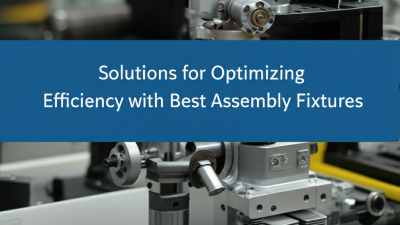

In today's competitive manufacturing landscape, the efficiency of production processes is paramount, and assembly fixtures play a crucial role in achieving optimal performance. According to a report by the Massachusetts Institute of Technology, companies implementing advanced assembly fixtures can see productivity increases of up to 30%, illustrating the significant impact these tools have on operational efficiency. As manufacturers face rising pressure to reduce costs while maintaining high-quality standards, the demand for innovative assembly fixture solutions is greater than ever.

This ultimate guide explores the best practices and strategies for optimizing assembly fixtures, empowering businesses to enhance their assembly processes, reduce cycle times, and ultimately drive profitability. By focusing on the latest trends and technologies in assembly fixture design and application, manufacturers can stay ahead of the curve and respond effectively to the evolving needs of the market.
As we look toward 2025, the assembly fixtures market is poised for significant transformation, driven by advancements in automation and the increasing demand for customized manufacturing solutions. According to a recent report by MarketsandMarkets, the global assembly fixtures market is projected to reach $7.2 billion by 2025, growing at a compound annual growth rate (CAGR) of 6.5% from 2020. This growth is largely attributed to the rise in industries such as automotive and electronics, where precision and efficiency are paramount.
One of the key insights is the shift towards smart assembly fixtures that integrate IoT technology. This development allows for real-time monitoring and data collection, enabling manufacturers to optimize workflows and reduce downtime. A study by Grand View Research indicates that automation in assembly processes can reduce cycle times by up to 25%, enhancing overall productivity. Furthermore, the push for sustainability in manufacturing is steering companies toward eco-friendly materials and energy-efficient designs, ensuring that assembly fixtures not only meet performance standards but also align with environmental goals. Embracing these trends will be essential for businesses looking to thrive in the competitive landscape of 2025 and beyond.
In today's manufacturing landscape, the role of assembly fixtures cannot be overstated, as these tools significantly impact the efficiency and precision of production lines. Assembly fixtures are designed to hold components securely in place, ensuring that every part is consistently aligned during the assembly process. This consistent positioning reduces variability, minimizes assembly errors, and ultimately leads to higher quality products. By applying the right fixture technology, manufacturers can streamline operations and enhance throughput.
Moreover, the integration of advanced materials and ergonomic designs in assembly fixtures contributes to operator comfort and safety, further boosting productivity. Workers are less likely to experience fatigue or injury when using fixtures designed to reduce physical strain, allowing them to focus on quality over quantity. Investing in optimized assembly fixtures not only enhances operational efficiency but also supports lean manufacturing practices, contributing to reduced waste and improved resource utilization.
Ultimately, effective assembly fixtures are integral to achieving higher efficiency in production lines, laying the groundwork for sustainable growth and competitive advantage.
In today’s competitive manufacturing landscape, optimizing efficiency is critical for success. Numerous companies are turning to innovative assembly fixtures that significantly enhance output. One notable case is that of a leading automotive manufacturer that implemented adjustable assembly fixtures tailored to various vehicle models. By allowing workers to adapt the setup for different tasks quickly, they reduced assembly time by 20%, streamlining their production process and improving overall workflow.
Another standout example comes from a consumer electronics firm that adopted modular assembly fixtures designed for easy reconfiguration. These fixtures enabled the team to switch between product lines without extensive downtime, facilitating a more agile manufacturing environment. As a result, the company reported a dramatic increase in productivity, achieving a 15% boost in output while simultaneously maintaining high-quality standards. Such innovative solutions not only drive efficiency but also foster a culture of continuous improvement, empowering companies to adapt to market demands swiftly.
In today's competitive manufacturing landscape, optimizing assembly fixtures is crucial for maximizing efficiency and ROI. Data-driven decision-making (DDDM) has emerged as a powerful approach, allowing organizations to leverage data analytics to make informed choices about assembly processes. According to a recent study, companies that implement data-driven techniques in their operations can see improvements in overall productivity by up to 30%. This highlights the significant potential of utilizing real-time data to enhance fixture design and functionality.
Tips for Optimization:
By focusing on data-driven methodologies, organizations can not only maximize the efficiency of their assembly fixtures but also ensure a higher return on investment, ultimately enhancing their competitive edge in the industry.
The assembly fixture industry is rapidly evolving, driven by innovative technologies that enhance efficiency and precision. One significant trend is the integration of automation and robotics into assembly processes. Advanced robotic systems can work in tandem with custom designed fixtures, drastically reducing assembly times and minimizing human error. This synergy allows for consistent quality while adapting to varying production demands, making it an essential strategy for modern manufacturing.
Another emerging trend is the use of augmented reality (AR) and virtual reality (VR) in the training and operation of assembly fixtures. These technologies provide operators with immersive training experiences, enabling them to practice assembly techniques in a virtual environment before applying them on the shop floor. Furthermore, AR can assist in real-time guidance, overlaying essential information on the assembly process, thus enhancing productivity and worker confidence. As these technologies become more prevalent, they are set to redefine the methodologies used in assembly fixture design and implementation, driving efficiency and innovation in the industry.
